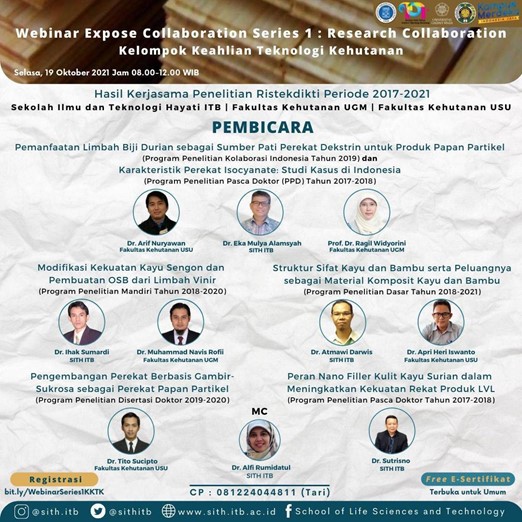Webinar Expose Collaboration Series 1: Fine Collaboration between ITB, UGM, and USU in Forestry Research

BANDUNG, itb.ac.id—The first Webinar Expose Collaboration series attended by the SITH ITB Forestry Technology Expertise Group, the UGM Faculty of Forestry, and the USU Faculty of Forestry was held virtually on Tuesday (19/10/2021). The event was opened with remarks by the Event Coordinator, Eka Mulya Alamsyah, Ph.D., Dean of the Faculty of Forestry, USU Dr. Rudi Hartono, Dean of the Faculty of Forestry UGM Dr. Sigit Sunarta, and Dean of SITH ITB Endah Sulistyawati, Ph.D.
Utilization of Durian Seed Waste as a Source of Dextrin Adhesive Starch for Particle Board Products
The first session opened with the presentation of the 2019 Indonesian Collaborative Research Program (PPKI) results conducted by Dr. Arif Nuryawan (USU), Dr. Eka Mulya Alamsyah (ITB), and Prof. Dr. Ragil Widyorini (UGM). This research was initially conceived because of the excessive amount of durian seed waste in Medan.
"Durian seeds have a high amylopectin content, so the adhesion is powerful," said Dr. Arif Nuryawan. This finding, he said, was the result after comparing durian seed starch with starch from other plant-based materials such as corn.
The conclusion is that the test of the physical properties of this adhesive, from the moisture content and density of the board, has complied with the JIS (Japan Industrial Standard) standard. "The addition of UF adhesive or urea formaldehyde to the dextrin adhesive can improve the mechanical properties, especially on the value of the internal adhesive strength and the screw holding strength of the particle board," explained Prof. Dr. Ragil. However, there are further suggestions to improve the thickness expansion properties and MOE and MOR properties for further research.
Modification of the Strength of Sengon Wood and Making OSB from Vinir Waste
The following presentation was made by Dr. Ihak Sumardi from ITB and Dr. Muhammad Navis Rofii from UGM. The purpose of this research was to evaluate the application of the phenol-formaldehyde impregnation technique on sengon wood in improving the quality of the wood, especially on its physicochemical properties.
In conclusion, phenol-formaldehyde resin impregnation can improve the hold wood's dimensional stability and general mechanical properties. Numerically, the density can be maximized from 0.26 kg/cm2 to 0.30 kg/cm2 with a weight percentage gain of 10%.
The Structure of Wood and Bamboo Properties and Their Opportunities as Wood and Bamboo Composite Materials
In session 2, the presentation of the 2018-2021 Basic Research Program (PD) results was delivered by Dr. Atmawi Darwis from ITB and Dr. Apri Heri Iswanto from USU. "Frankincense and raru are tree species that are known in the people of North Sumatra with high economic value resins," explained Dr. Atmawi Darwis.
"The studies conducted on frankincense and raru wood are not limited to the wood, we also collaborate with various research institutions to study nurseries, seed propagation, and morphological characteristics," added Dr. April Heri Iswanto. This collaborative research has produced approximately six publications related to frankincense and raru wood.
In conclusion, the resin from the frankincense tree is produced from epithelial cells formed from the traumatized canals that are full and enveloped—tapping up to eight points. This is what is most likely to cause the resin channels to collect.
Development of Gambier-Sucrose-Based Adhesives as Particle Board Adhesives
Unlike the previous ones, the research results presented this time were the 2019 – 2020 Doctoral Dissertation Research Program that Dr. Tito Sucipto presented from USU. Tito said that synthetic adhesives such as formaldehyde, isocyanates, and vinyl acetate are essential but not biodegradable and cause emissions. This study concluded that the use of gambier-based adhesive as an adhesive for bamboo betung particleboard produced the best board at 30?hesive content treatment. In addition, 100% gambier adhesive uses a compression temperature of 220oC.
The Role of Surian Bark Nano Filler in Improving the Adhesive Strength of LVL Products
The last presentation of the material was delivered by Dr. Sutrisno from ITB, with Dr. Ragil Widyorini from UGM as the guiding researcher. "The production and supply of logs from natural forests has decreased and is not sufficient to meet domestic demand for wood. For that reason, it is necessary to utilize fast-growing wood species from plantations and community forests using the right technology," she said regarding the formulation of the problem she raised.
At the end of the study, it was concluded that surian bark has better thermal properties than wheat flour filler because it has an initial temperature and peak temperature of the melting phase transition. After all, wheat flour as a filler has a faster decomposition time.
Reporter: Athira Syifa PS (Post-harvest Technology, 2019).
Translator: Billy Akbar Prabowo (Metallurgical Engineering 2020)

scan for download





